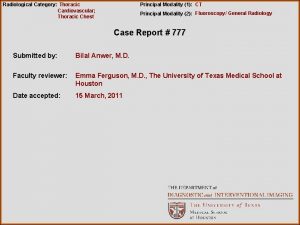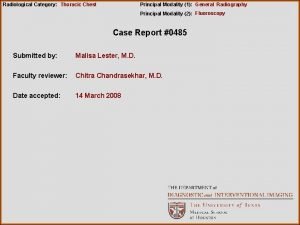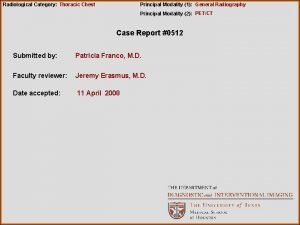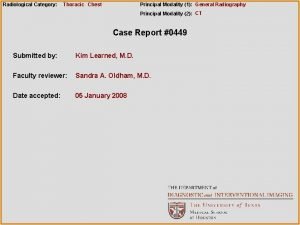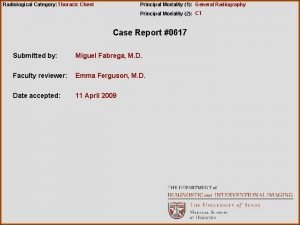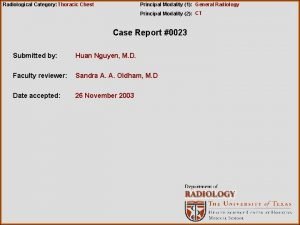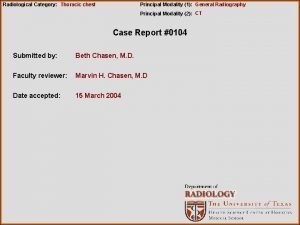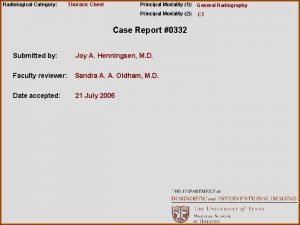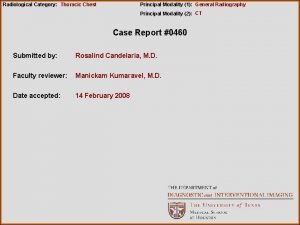Radiological Category Thoracic Chest Principal Modality 1 General










- Slides: 10

Radiological Category: Thoracic Chest Principal Modality (1): General Radiography Principal Modality (2): CT Case Report #0400 Submitted by: Andrew Potter, M. D. Faculty reviewer: Emma Ferguson, M. D. Date accepted: 30 March 2007

Case History 50 -year-old African-American female with known malignancy presents with increasing dyspnea. The patient recently discovered a lump in her left axilla. This led to mammography and breast ultrasound examinations, and eventually to percutaneous biopsy of a left axillary tail mass.

Radiological Presentations

Radiological Presentations

Test Your Diagnosis Which one of the following is your choice for the appropriate diagnosis? After your selection, go to next page. • Tuberculosis • Hypersensitivity pneumonitis • Metastases • Sarcoidosis • Pneumoconiosis

Findings and Differentials Findings: PA and lateral radiographs demonstrate innumerable small nodules in a miliary pattern. Also, increased opacity in the right base obscures the heart border with depression of the minor fissure. The lateral image confirms right middle lobe atelectasis. CT imaging through the lung bases confirms milary nodules in the lung and atelectasis of the right middle lobe. The abdominal image reveals bilateral adrenal masses and subcutaneous lesions. Differentials: • Metastases • Miliary infection

Discussion The miliary pattern is described as innumerable small (1 -3 mm) nodules with sharp margins. Although multiple entities can present in this fashion, metastatic disease and miliary infection are most common. Miliary infection, while commonly tuberculosis, may also include non-tuberculous mycobacteria, fungal and viral pathogens. Often the presenting patient is immunocompromised. Additional considerations such as sarcoidosis, hypersensitivity pneumonitis and pneumoconioses are suggested by patient history once infection and metastatic disease are excluded. High-resolution CT can be helpful in differentiation. In this case, the additional findings of bilateral adrenal and subcutaneous masses, in conjunction with patient history of malignancy favors metastatic spread of disease.

Discussion The chest wall biopsy revealed atypical carcinoid with spindle-cell features. Histologic observations such as central necrosis and 18 mitotic figures per 10 high -powered-fields confirm the aggressive nature of the tumor. Neuroendocrine tumors of the lung originate from Kulchitzky cells. They include a spectrum of typical carcinoid, atypical carcinoid, large-cell neuroendocrine tumor, and small cell lung carcinoma, in increasing order of aggressiveness. While the prognosis of atypical carcinoid is worse than typical carcinoid, imaging findings are indistinguishable.

References • Andreu J, Mauleon S, et al. Miliary lung disease revisited. Curr Probl Diagn Radiol 2002; 31: 189 -97. • Chong S, Soo Lee K, et al. Neuroendocrine tumors of the lung: Clincal, pathologic, and imaging findings. Radiographics 2006; 26: 41 -58. • Mezzetti M, Raveglia F, et al. Assessment of outcomes in typical and atypical carcinoids according to the latest WHO classification. An Thorac Surg 2003; 76: 1838 -42. • Asamura H, Kameya T, et al. Neuroendocrine neoplasms of the lung: A prognostic spectrum. J Clin Oncol 2006; 24: 70 -76.

Diagnosis Atypical carcinoid with miliary pulmonary metastases
 Aerohive erate
Aerohive erate Tennessee division of radiological health
Tennessee division of radiological health Center for devices and radiological health
Center for devices and radiological health National radiological emergency preparedness conference
National radiological emergency preparedness conference Radiological dispersal device
Radiological dispersal device Lexical vs auxiliary verbs
Lexical vs auxiliary verbs Skill focus: persuasion
Skill focus: persuasion Pacs modality workstation
Pacs modality workstation Capacitive field diathermy
Capacitive field diathermy Sensory vs somatic
Sensory vs somatic Sodality vs modality
Sodality vs modality











